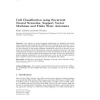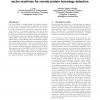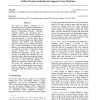39 search results - page 2 / 8 » Understanding Support Vector Machine Classifications via a R... |
KAIS
2006
13 years 4 months ago
2006
Our objective is spoken language classification for helpdesk call routing using a scanning understanding and intelligent system techniques. In particular, we examine simple recurre...
EVOW
2006
Springer
13 years 8 months ago
2006
Springer
Infection by the human papillomavirus (HPV) is associated with the development of cervical cancer. HPV can be classified to highand low-risk type according to its malignant potenti...
JMLR
2006
13 years 4 months ago
2006
Support vector machines utilizing the 1-norm, typically set up as linear programs (Mangasarian, 2000; Bradley and Mangasarian, 1998), are formulated here as a completely unconstra...
RECOMB
2002
Springer
14 years 5 months ago
2002
Springer
One key element in understanding the molecular machinery of the cell is to understand the meaning, or function, of each protein encoded in the genome. A very successful means of i...
ICML
2004
IEEE
14 years 5 months ago
2004
IEEE
The goal of feature induction is to automatically create nonlinear combinations of existing features as additional input features to improve classification accuracy. Typically, no...



